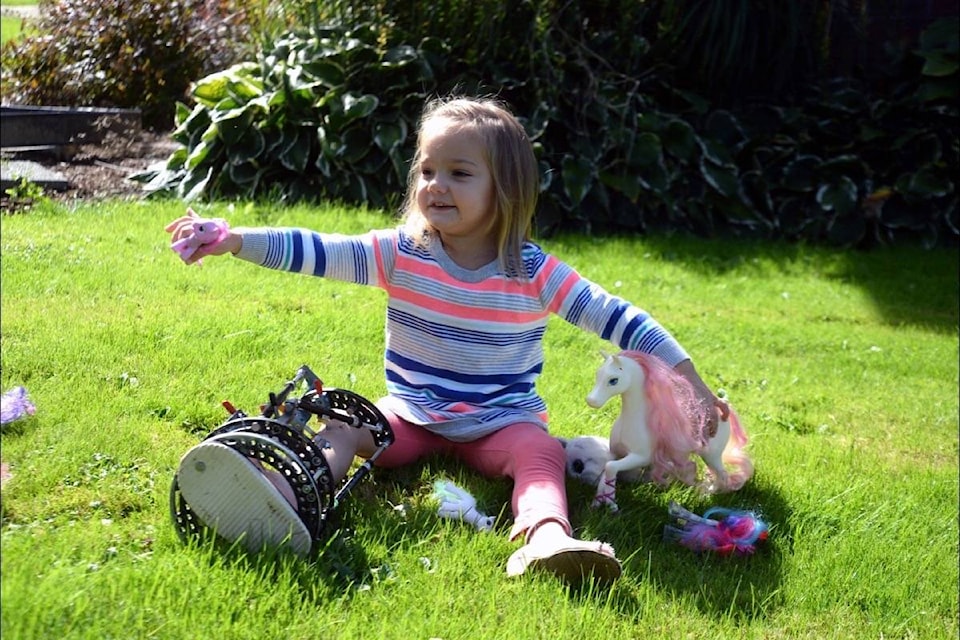Running through the house as she plays with her sister, climbing over furniture and jumping up and down as the two imagine a make-believe world with their toy ponies, any onlooker would have no clue how much three-year-old Joelle VanLaar has gone through.
That is of course, until they noticed the wire contraption around her right leg, with 14 pins sticking into the Agassiz girl’s calf, foot and ankle.
Joelle was born with an extremely rare birth defect called fibular hemimelia, causing one leg to be shorter by about 10 centimetres and malformed –lacking the fibular bone, some key muscles and one toe, with two other toes connected.
The simple name of the contraption attached to her tiny leg is an ‘external fixator,’ a device that helped to slowly lengthen her leg over a course of months.
Implanted during an intense, three-part, eight-hour surgery that also addressed issues with her ankle and the direction of her leg, the fixator helped Joelle’s leg gain five centimetres of length. It will remain on until the bone growth heals and becomes solid.
But the problem with lengthening the leg of a three-year-old is that her limbs will continue to grow.
That mean’s Joelle will need another surgery, likely around age 11 or 12, when she hits her next big growth spurt.
“As she grows, it will continue to [cause a] discrepancy again and then we will have to do surgery again,” said her mom, Ashley VanLaar, adding that Joelle will also need more reconstructive surgeries.
| Ashley VanLaar with daughter Joelle, 3. Joelle has taken on surgeries, infections and orthotics to correct a rare birth defect that saw her born with a shorter, malformed right leg. (Nina Grossman/The Observer) |
Fibular hemimelia is extremely rare – it occurs about once in 40,000 births, according to the Paley Orthopedic and Spine Institute. In fact, the condition is so rare VanLaar says doctors weren’t sure how to diagnose Joelle when she was born.
“[The doctor] had never seen it, and had never heard of it. So he did a bunch of research while we were in hospital and then he got us a bunch of pamphlets from England and said, ‘this is all I could find on it.’”
Still, that’s better than it once was. VanLaar believes that if Joelle had been born a few years earlier, her leg would have been amputated without question.
And Joelle’s doctor has told her that ‘amputation is always on the table.’
“There’s also some kids who do the whole process like this, and for some reason it just doesn’t work for [them], there’s too much pain with nerves and muscles and they hit their medical age of 18, and they get it amputated,” said VanLaar. “You just hope as parents and as a family that this is the best thing for her, and we put a lot of trust and confidence into the doctors and their opinions.”
Related: Langley child in ‘excruciating’ pain pleads for PharmaCare to cover drug
It might be that she’s three-years-old, or it might be that she’s just a tough cookie, but for the most part, Joelle hardly seems to notice that she’s different from her four siblings.
But that’s just what others see.
VanLaar says she spent the previous night up with her daughter, putting ice packs on her leg to help with the pain and treating the pin sites – open wounds prone to infection, of which Joelle has already suffered at least one.
And VanLaar wonders sometimes if Joelle’s occasional outbursts and fits of anger are an expression of the pain she has lived with off an on since birth.
“None of her siblings ever screamed like she does,” Van Laar said.
Fibular hemimelia isn’t life threatening, but it will always be a part of Joelle’s life, something the three-year-old can’t grasp at this point, but her parents are starting to come to terms with.
Even after she stops growing, many patients live with lifelong arthritis, hip or leg pain.
“It won’t end with this surgery, and it won’t end with the next surgery,” VanLaar said. “It’s going to be a life-long battle for her.”
VanLaar says some of her daughter’s indifference to the metal fixator on her leg has to do with age, and she knows that will change.
“She still troops through. She climbs ladders, playgrounds, there’s nothing that will slow her down. She does know that it’s different, but I think cause she’s three, she’s very innocent to what other people think,” VanLaar said.
“But I know from talking to other people and teenagers who have [fibular hemimelia] that the worst is not over yet.”
No one knows for sure what will happen – technology could advance – but as it stands, it’s likely Joelle will have to learn to live with fibular hemimelia and its ramifications for the rest of her life.
| At one point Joelle was in the hospital at least once a week. She was couch-bound during the recovery period after a major surgery to correct the length and other issues with her leg, but now the three-year-old enjoys playing with her siblings and doesn't seem to let the condition get her down. (Submitted) |
That’s why VanLaar hopes more research will go into the rare condition. She and her husband Geoffrey are attending the first ever Walk Tall Gala in Vancouver on Nov. 1, 2018.
The gala supports the BC Children’s Hospital’s limb lengthening and reconstruction program, helping with research to enable all kids to enjoy life and pursue their dreams without limitations.
For more information on the gala and to find out how you can help, visit walktall.ca.
